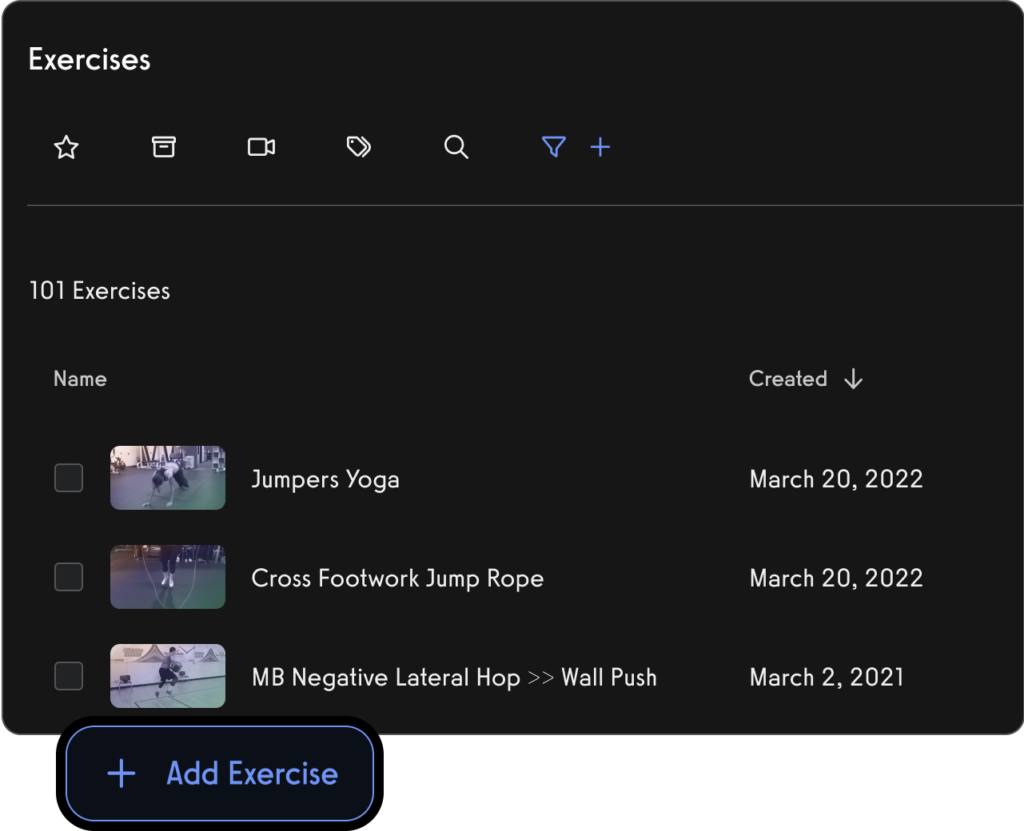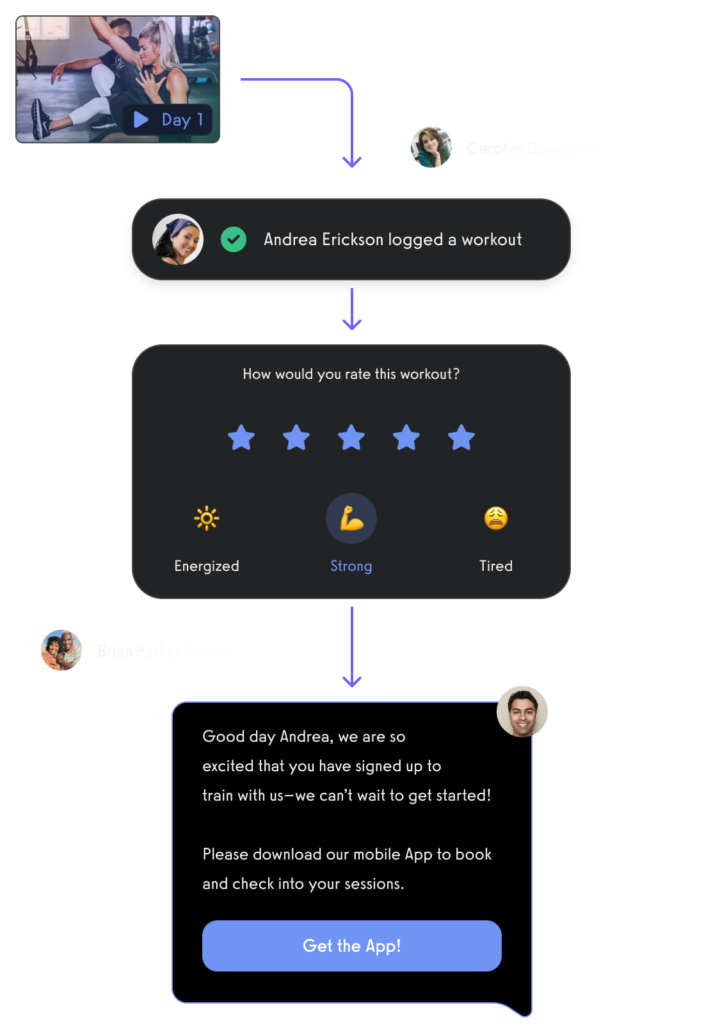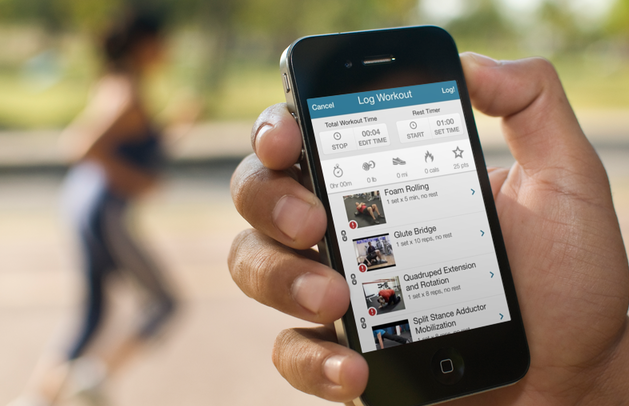How to Make a Physical Therapy App in 2025
Learn how to make a physical therapy app with physical therapy appointment booking, payments, messaging, HEP physical therapy exercise software, and more.

To create an effective physical therapy app quickly and affordably, utilizing a platform like Exercise.com is the optimal strategy. Developing an app from scratch is not only costly and time-consuming but also requires deep technical and regulatory knowledge, especially important in the health and therapy sectors. Exercise.com offers a solution that is tailor-made for health professionals who are considering a DIY physical therapy app but don’t want all the hassle, providing all the necessary tools to manage client schedules, track therapeutic progress, and deliver customized treatment plans.
Book physical therapy appointments in your PT app.

Create HEP Home Exercise Program workout plans for your patients to do at home.

Offer messaging and powerful automations.

And much, much more.
Exercise.com is particularly suited for physical therapists looking to enhance their service delivery through digital means. The platform simplifies the process by offering built-in features that are essential for a physical therapy practice, such as secure medical data compliance, appointment scheduling, and patient management. This enables therapists to focus more on patient care and less on app development complexities.
Here’s how to use Exercise.com to build your physical therapy app free of stress and with no coding. Then see why the best martial arts studio software, the best gym software, the best personal training software, and the best fitness software for fitness influencers is all found on the Exercise.com platform.

Step #1 – Define Your App’s Core Functionalities
Identify the specific features that will make your physical therapy app beneficial for both therapists and patients.
- Patient Management: Efficiently manage patient profiles, including their health history, treatment plans, and session notes.
- Appointment Scheduling: Allow patients to book and manage appointments directly through the app.
- Exercise Database: Include a library of therapeutic exercises with instructions and videos.
Exercise.com allows for deep customization, ensuring these features align perfectly with the unique needs of your physical therapy practice.
Read More: Best Physical Therapy HEP Exercise Software
Step #2 – Ensure Compliance and Security
Given the sensitivity of health data, your app must comply with medical privacy laws such as HIPAA in the U.S.
- Data Security: Implement robust encryption methods to secure patient data.
- Compliance Features: Incorporate features that ensure your practice remains compliant with health care regulations.
- Secure Messaging: Offer a safe communication channel for patients to discuss their progress and concerns.
Exercise.com provides a secure platform that adheres to the necessary regulatory standards, ensuring that your app is both compliant and secure.
Read More: Exercise.com HIPAA Compliance
Step #3 – Integrate Treatment and Progress Tracking Tools
Tools that track patient progress and adapt treatments are vital for physical therapy.
- Customizable Plans: Enable therapists to create and modify treatment plans based on patient progress.
- Progress Tracking: Allow patients to log their exercises, pain levels, and feedback on their treatments.
- Outcome Measures: Utilize tools to assess the effectiveness of prescribed treatments over time.
With Exercise.com, you can easily incorporate these advanced tracking and treatment features, enhancing the therapeutic outcomes for your patients.
Read More:
Step #4 – Develop Educational Resources
Providing patients with resources to understand their conditions and treatments can significantly enhance treatment efficacy.
- Educational Content: Offer articles, videos, and FAQs about common physical therapy treatments and techniques.
- Interactive Guides: Include interactive diagrams and videos that explain anatomy and exercises.
- Feedback System: Implement a system for patients to ask questions and receive professional advice.
Exercise.com supports the integration of rich educational content, making it simpler to educate and engage your patients effectively.
Step #5 – Test and Launch Your App
Before launching, thoroughly test your PT app with real users to iron out any issues.
- Pilot Testing: Run a pilot test with a small group of patients and therapists to gather feedback.
- Refinement: Make necessary adjustments based on the pilot test to improve functionality and user experience.
- Marketing Strategy: Develop a marketing plan to launch your app to your patient base and beyond.
Exercise.com not only facilitates the development process but also provides marketing tools to help promote your new app effectively.
By following these steps with Exercise.com, you can create a functional and compliant physical therapy app that enhances patient care and streamlines your practice management. Ready to develop your app? Book a demo with Exercise.com today and start transforming your physical therapy practice.

Best Physical Therapy App Features
When developing a physical therapy app, incorporating certain key features can make the app more effective for both therapists and patients. Here are the best features to include:
#1 Patient Management
- Functionality: Enables therapists to manage patient profiles, treatment histories, and medical notes efficiently.
- Importance: Central to organizing and accessing essential patient information quickly and securely.
#2 Secure Appointment Scheduling
- Functionality: Allows patients to book, reschedule, or cancel their appointments directly through the app.
- Importance: Enhances patient convenience and optimizes clinic scheduling.
#3 Exercise Database with Instructions
- Functionality: Provides a comprehensive library of exercises complete with detailed instructions and demonstration videos.
- Importance: Essential for ensuring patients perform exercises correctly outside of clinic hours.
#4 Progress Tracking and Reporting
- Functionality: Offers tools for patients to log their exercises, symptoms, and pain levels, providing therapists with real-time progress reports.
- Importance: Crucial for monitoring patient progress and adjusting treatments as needed.
#5 HIPAA-Compliant Communication Tools
- Functionality: Includes secure messaging features that comply with HIPAA regulations for safe communication.
- Importance: Allows for secure discussions about patient care and progress without compromising privacy.
#6 Educational Resources
- Functionality: Features educational content about physical therapy procedures, injury prevention, and self-care techniques.
- Importance: Empowers patients with knowledge about their conditions and treatments, enhancing their engagement and compliance.
#7 Payment Processing
- Functionality: Integrates secure payment options for handling co-pays and other charges.
- Importance: Streamlines the payment process, making it easier for both the practice and the patients.
#8 Custom Treatment Plans
- Functionality: Enables therapists to create and customize treatment plans directly within the app.
- Importance: Tailors therapy to individual patient needs, improving treatment outcomes.
#9 Feedback and Survey Tools
- Functionality: Collects feedback from patients regarding their treatments and overall service satisfaction.
- Importance: Provides valuable insights that can help improve the quality of care and patient experience.
#10 Compliance and Security Features
- Functionality: Ensures that the app meets all necessary legal and ethical standards required in healthcare.
- Importance: Protects patient data and ensures the clinic operates within legal requirements.
Exercise.com provides a platform that can integrate all these essential features into a cohesive and effective physical therapy app. By choosing Exercise.com, you ensure your app is not only functional but also compliant with industry standards and beneficial to patient care. Ready to start building your physical therapy app? Book a demo with Exercise.com today.

How do you create an app for physical therapy?
Creating an app for physical therapy involves a few key steps:
- Identify the specific needs of your patients and practice: This includes functionalities such as exercise demonstrations, progress tracking, appointment scheduling, and direct communication.
- Choose a development approach: You can either opt for custom app development or use a platform like Exercise.com, which provides customizable templates and functionality specifically tailored for health and fitness applications, including physical therapy.
- Integrate features tailored to physical therapy: Essential features should include video tutorials for exercises, pain and progress logs for patients, secure messaging for communication, and remote monitoring capabilities to adjust treatment plans as needed.
What is the best physical therapy HEP (Home Exercise Program) software?
The best physical therapy HEP software should offer comprehensive tools to effectively manage and deliver customized home exercise programs for patients. Some of the top-rated HEP software includes:
- MedBridge: Known for its extensive library of high-quality videos and its ability to create personalized exercise programs that can be easily shared with patients.
- PT Distinction: Offers robust tools for creating and managing home exercise programs along with client tracking and engagement features.
- Exercise.com: While traditionally used for fitness, it offers adaptable features that can be excellent for creating, managing, and tracking physical therapy exercises for patients.
These platforms facilitate effective communication between therapists and patients, ensuring exercises are performed correctly and progress is closely monitored.
Read More: Best Physical Therapy HEP Software
How do I use my physical therapy app to deliver exercises for my patients to do at home?
To use a physical therapy app to deliver exercises for patients at home, ensure the app includes the following functionalities:
- Customizable exercise libraries: Allow therapists to create or modify exercises specific to each patient’s needs and abilities.
- Video demonstrations: Help patients understand how to perform exercises correctly to prevent injuries and ensure efficacy.
- Progress tracking: Enable patients to log their progress, pain levels, and feedback on exercises, which can be monitored by therapists to adjust treatment plans.
- Communication tools: Provide a direct line of communication for patients to ask questions or report issues, enhancing their confidence and adherence to the exercise regimen.
By integrating these features into your physical therapy app, you can deliver a comprehensive home exercise program that supports patient recovery and enhances their overall therapy experience.











